What Color is Your Food? (FN595, Revised Aug. 2016)
Availability: Web only
Taste a rainbow of fruits and vegetables for better health
Eat more fruits and vegetables every day!
People who eat more generous amounts of fruits and vegetables as part of a healthy diet are likely to have reduced risk of chronic diseases, including strokes, type 2 diabetes, some types of cancer, and perhaps heart disease and high blood pressure.
What’s a serving size anyway?
Recommendations for fruits and vegetables are now in cups. One cup equals:
1 small apple
1 large banana
2 cups of raw greens
12 baby carrots
1 large orange
1 large bell pepper
1 medium grapefruit
1 large sweet potato
People need different amounts of fruits and vegetables depending on their age, gender and amount of daily physical activity. To learn your daily recommendation, visit this site.
For example, the recommendation for a 40-year-old male who gets about 60 minutes of daily physical activity is 2 cups of fruit and 3½ cups of vegetables. The recommendation for a 15-year-old female who gets less than 30 minutes of daily physical activity is 1½ cups of fruit and 2½ cups of vegetables.
To meet their daily goal, most people need to increase the amount of fruits and vegetables they eat every day. All product forms count – fresh, frozen, canned, dried and 100% juice. Whole fruits, however, usually contain more fiber than juice.
Sample the spectrum of fruits and vegetables
Scientists are regularly reporting new health benefits associated with fruits and vegetables. Eating more fruits and vegetables is a worthwhile goal. Eating a variety of different colors of fruits and vegetables every day is a new way of thinking about meeting the goal.
Healthy reasons to eat a rainbow of colorful fruits and vegetables
Red fruits and vegetables are colored by natural plant pigments called “lycopene” or “anthocyanins.” Lycopene in tomatoes, watermelon and
pink grapefruit, for example, may help reduce risk of several types of cancer, especially prostate cancer. Lycopene in foods containing cooked tomatoes, such as spaghetti sauce, and a small amount of fat are absorbed better than lycopene from raw tomatoes.
Anthocyanins in strawberries, raspberries, red grapes and other fruits and vegetables act as powerful antioxidants that protect cells from damage. Antioxidants are linked with keeping our hearts healthy, too.
These are some examples of the red group:
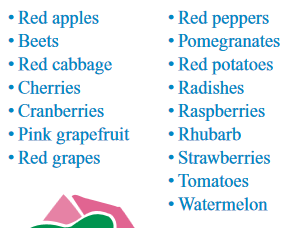
One study found that people who ate a diet high in carotenoid-rich vegetables were 43 percent less likely to develop age-related macular degeneration, an eye disorder common among the elderly, which can lead to blindness.
Carotenoids also may be good for your heart. One study found that men with high cholesterol who ate plenty of vegetables high in carotenoids had a 36 percent lower chance of heart attack and death than their counterparts who shunned vegetables.
Citrus fruits like oranges are not a good source of vitamin A. They are an excellent source of vitamin C and folate, a B vitamin that helps reduce risk of birth defects.
Some examples of the orange/yellow group include:
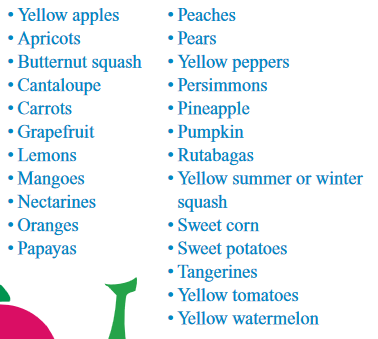
The “indoles” in broccoli, cauliflower, cabbage and other cruciferous vegetables may help protect against some types of cancer. Leafy greens such as spinach and broccoli are excellent sources of folate, a B vitamin that helps reduce risk of birth defects.
Some examples of the green group include:
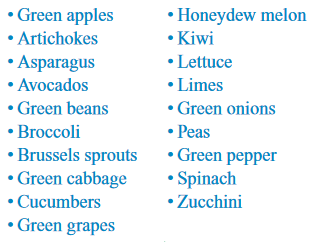
These are some examples of the blue/purple group:
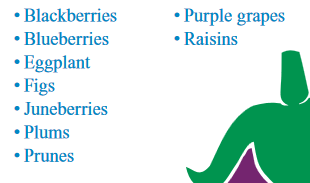
such as bananas and potatoes, are good sources of the mineral potassium, too.
Some examples of the white group include:
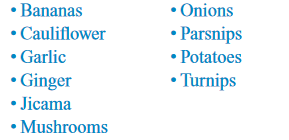
How are you doing?
If you’re like many Americans, your plate may benefit from some added color from fruits and vegetables.
1. Write down all the fruits and vegetables you ate yesterday, or keep track of what you eat today. Did you have any fruit for breakfast? Lunch? Snacks? Dinner?
2. What color groupings did you try?
Add some color to your plate
This menu for a day is missing fruits and vegetables. Add some fruits and vegetables to each meal or snack, and try to include some fruits and/or vegetables from each color grouping. Keep the main items the same. There are no “right” or “wrong” answers. A colorful menu follows, with a nutrition analysis of both menus.

Colorful and nutritious menu makeover

Nutrition analysis of menus
As the following table shows, adding fruits and vegetables increases nutrients essential to good health without adding lots of calories and fat. The Nutrition Facts label doesn’t list all the beneficial phytochemicals in a more colorful diet – like lycopene and lutein – but they are included in the
table below.
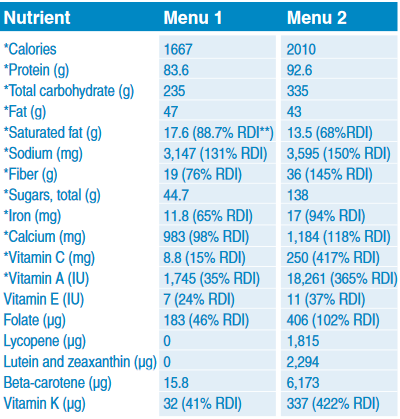
**RDI = “Recommended Daily Intake.” RDIs are based on U.S. Recommended Daily Allowances.
Key: g = grams; mg = milligrams; IU = International Units; µg = micrograms
Tips to increase fruits and vegetables in your diet
Eat a variety of food groups from all the food groups every day. Check the strategies you will try:
❏ Keep cleaned fruits and vegetables in the refrigerator — ready to eat.
❏ Have vegetables with low-fat dip for a snack.
❏ Try commercial prepackaged salads and stir-fry mixes to save prep time.
❏ Add vegetables to casseroles, stews and soups.
❏ Drink 100% fruit juice instead of fruit-flavored drinks or soda pop.
❏ Have fruit for dessert.
❏ Keep a bowl of apples, bananas and/or oranges on the table.
❏ Choose a side salad made with a variety of leafy greens.
❏ Bake with raisin, date or prune puree to reduce fat and increase fiber.
❏ Add lettuce, onions, peppers and/or tomatoes to sandwiches.
❏ Order veggie toppings on your pizza.
❏ Enjoy fruit smoothies for breakfast or snacks.
❏ Pack fresh or dried fruits for quick snacks.
Fruit and vegetable safety
Improperly handled fruits and vegetables can become contaminated with Salmonella and E. coli, potentially leading to foodborne illnesses. Fresh fruits and vegetables should be washed well with plenty of running water to be safe. Cross contamination must also be avoided. Follow these tips to keep produce safe from store to home:
● Examine fresh fruits and vegetables for signs of freshness before purchase.
● Pack fresh produce away from meats in the grocery cart and in separate bags.
● Wash hands with warm water and soap for 20 seconds before preparing fruits and vegetables.
● Rinse all fresh produce with running water, using a brush if necessary. Do not use soap.
● Remove outer leaves of lettuce and cabbage.
● Use separate cutting boards for cutting up fresh produce and for meat.
● Clean cutting boards with soap and water. Sanitize with a solution of 1 tsp. bleach per 1 quart water.
● Serve cut-up fresh produce in containers over ice.
● Store cut-up fruits at or below 40 degrees.
Set some goals
List two goals about adding colorful fruits and vegetables to your diet. Check back in a month to see your progress. Then set some new ones!
Web-based resources with fruit and vegetable information:
— A site sponsored by the Centers for Disease Control and Prevention, Department of Health and Human Services, National Cancer Institute. It features interactive tools, recipes and links
— NDSU Extension Service food and nutrition site with information about nutrition, preparation and preservation of a variety of foods
Reviewed and August 2016

